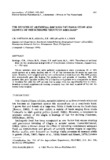The effects of artificial diets on fry production and growth of Oreochromis niloticus breeders
Share
Abstract
Tilapia breeders were fed with pelleted supplemental diets containing 20 or 40% crude protein at a daily feeding rate of 1% of fish biomass for 24 weeks in cages and tanks. Breeders were weighed and fry were collected at 3-week intervals. The 40% protein diet consistently gave the highest fry production and growth of breeders. The 20% protein diet gave variable results; fry production and growth were comparable to those of breeders fed with the 40% protein diet in some trials but significantly low in others. Breeders without supplemental feeding invariably had the least number of fry and the lowest body weights.
Description
Contribution No. 153 of the Aquaculture Department, SEAFDEC.
Suggested Citation
Santiago, C. B., Aldaba, M. B., Abuan, E. F., & Laron, M. A. (1985). The effects of artificial diets on fry production and growth of Oreochromis niloticus breeders. Aquaculture , 47(2-3), 193-203. https://doi.org/10.1016/0044-8486(85)90065-1
Subject
Collections
- AQD Journal Articles [1249]


